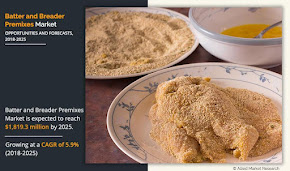Milk Powder Market Expected to See Massive Growth by 2031
According to a new report published by Allied Market Research, titled, “Milk Powder Market," The milk powder market size was valued at $29.6 billion in 2021, and is estimated to reach $50.7 billion by 2031, growing at a CAGR of 4.8% from 2022 to 2031.
Milk powder is a dried dairy product, prepared by evaporating milk to
eliminate the majority of the moisture content and then spraying the remaining
liquid through a nozzle to generate a vapor that dries and forms minute
particles. The milk powder can be reconstituted with water to produce liquid
milk or used as a component in a variety of culinary preparations. Milk powder
comes in a variety of forms, including whole milk powder, skim milk powder,
buttermilk powder, and others. Milk powder can also be fortified with mineral
and vitamin supplements to enhance its nutritional value.
Download Free Sample Copy @ https://www.alliedmarketresearch.com/request-sample/3396
According to the United Nations Food and Agriculture Organization (FAO),
around 150 million families worldwide produce milk. While most developing
countries produce their food on small family farms, developed nations have
rapidly shifted to large-scale industrial enterprises. In 2022, all of these
firms generated around 930 million tons of milk. The cows account for more than
80% of overall production across all species. This rate accounted for almost
100% of production in developed countries. The dairy industry involves the
production of milk, its processing for sale, and the manufacture of dairy
products. Dairy product consumption is increasing at a decent pace,
particularly in developing countries, because of the rising nutritional value
of milk and milk products. Due to the growing worldwide population and changing
customer demands, the dairy business has been developing for many years. Milk
powder is one of several dairy products made possible by the rapid growth of
dairy processing equipment and technology. Demand for milk powder is driven by
the benefits of a longer product shelf life, improved product diversity,
convenience, simpler warehousing, and less expensive transportation.
Emulsifiers are one of the components used in the production of milk
powder. Emulsifiers are additions derived from plant, animal, and synthetic
sources that aid in the smooth texture of milk powder and similar processed
goods, prevent separation, and improve shelf life. The U.S. Food and Drug
Administration rigorously regulates and tests the safety of emulsifiers. The
emulsifiers are classified as Generally Recognized as Safe (GRAS) and are
permitted at defined quantities in certain types of food and drinks. Based on
the greatest scientific knowledge, the FDA analyses the safety of approved
additives on a regular basis to decide if approvals should be amended or
revoked. According to the National Center for Biotechnological Information,
artificial emulsifiers such as polysorbate 80 enhance bacterial translocation
through the gut wall, systemic inflammation, and metabolic syndrome. This
raises the possibility that dietary emulsifiers play a role in diseases such as
heart disease, type 2 diabetes, and Crohn's disease. The presence of
emulsifiers in milk powder reduces the attractiveness of milk powder as a
healthy option and limits the milk powder market opportunities for
expansion.
During the pandemic and countrywide lockdowns, many consumers began
cooking and baking at home. This aspect increased demand for its retail
packaging in developing as well as developed nations. Premium grade has gained
popularity among clients in developed countries in recent years. The market for
quality milk powder is expected to grow as consumer discretionary income levels
rise. Milk powder is an essential component in dining establishments, cafés,
and catering enterprises across the world. Its use in various cuisines served
fresh in cafés and restaurants has grown due to shifting customer demands. In
the upcoming years, milk powder market growth is predicted to be driven by the
newly popular habit of eating out and buying ready meals.
The milk powder market is segmented into type, application, and region.
By type, the market is classified into whole milk powder, skimmed milk powder,
dairy whitener, buttermilk powder, fat filled milk powder, and others. By
application, the market is divided into nutritional food, infant formula,
confectionery, baked sweets, savories, and others. Region-wise, the market is
analyzed across North America (the U.S., Canada, and Mexico), Europe (UK,
Germany, France, Spain, Italy, and the rest of Europe), Asia-Pacific (China,
Japan, India, South Korea, Australia, and the rest of Asia-Pacific), and LAMEA
(Brazil, Saudi Arabia, South Africa, and rest of LAMEA).
Players operating in the global milk powder market have adopted various
developmental strategies to expand their milk powder market share, increase
profitability, and remain competitive in the market. Key players profiled in
this report include Arla Foods amba, Fonterra Co-operative Group Limited,
Nestle S.A., Saputo Inc., Schreiber Foods Inc., The Kraft Heinz Company, Groupe
Lactalis, Dairy Farmers of America, Inc., Danone S.A, and Royal Frieslandcampina
N.V.
Key findings of the study:
- According to milk powder market analysis, on
the basis of type, whole milk powder segment dominated the milk powder
industry in 2021 and is expected to retain its dominance throughout the
forecast period.
- According to milk powder market trends, on the
basis of application, confectionery segment dominated the global milk
powder market in 2021 and is expected to retain its dominance throughout
the milk powder market forecast period.
- Region wise, Asia-Pacific region accounted for
the highest market share in the milk powder market in 2021 and is expected
to grow at a CAGR of 4.0%.
Request For Customization@ https://www.alliedmarketresearch.com/request-for-customization/3396
Contact
us:
David
Correa
Allied Analytics LLP
+1-800-792-5285




Comments
Post a Comment